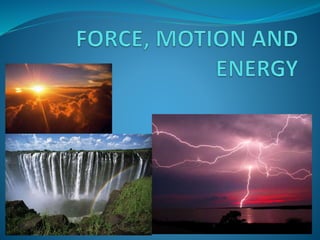
Force, motion and energy
- 2. Laws of Motion An object at rest can be moved by applying an external force on it.
- 3. What Are Newton’s Laws of Motion? Galileo was the first to suggest that uniform speed or straight-line motion was just as natural as at-rest state of motion. Galileo’s work profoundly influenced Sir Isaac Newton, the originator of the laws of motion.
- 4. Balanced and Unbalanced Forces Forces can produce changes in motion. There is a change in motion when: an object at rest starts to move, an object in motion changes speed, an object in motion stops. The forces that is capable of changing the state of motion of an object is called net force. Force can speed up or slow down a moving object. It produces an acceleration(vector quantity).
- 5. The net force is zero when the two forces are equal and they act in opposite directions. These forces are said to be balanced forces. An unbalanced force, on the other hand, is a nonzero net force. An unbalanced force or net force produces acceleration.
- 6. Law of Inertia Galileo defined inertia as the tendency of an object to maintain its initial state of motion. Originally, Newton called mass a quantity of matter, but later redefined it as a measure of inertia. Inertia states that a body at rest remains at rest, and a body already in motion remains in motion with a constant velocity, in the absence of an unbalanced applied force.
- 8. Law of Acceleration When there is a net force, how does the velocity of the object change?
- 9. Law of Force and Acceleration, a force upon an object causes it to accelerate according to the formula net force = mass x acceleration. So the acceleration of the object is directly proportional to the force and inversely proportional to the mass. The acceleration of an object as produced by a net force is directly proportional to the magnitude of the net force, in the same direction as the net force, and inversely proportional to the mass of the object. As the force acting upon an object is increased, the acceleration of the object is increased. As the mass of an object is increased, the acceleration of the object is decreased.
- 10. Units of Mass, Acceleration and Force System Quantity Mass Acceleration Force MKS kg m/𝑠2 𝑁 = 𝑘𝑔⦁𝑚/𝑠2 CGS g 𝑐𝑚/𝑠2 𝑑𝑦𝑛𝑒 = 𝑔⦁𝑐𝑚/𝑠2
- 11. For every action, there is an equal and opposite reaction. A force is a push or a pull that acts upon an object as a results of its interaction with another object. Forces result from interactions! The Law of Interaction
- 12. Exercise #1 What law of motion is illustrated by: 1. a rifle that coils when fired? 2. a truck that has a more powerful engine than a small compact car? 3. a rocket that lifts off from a space-shuttle system? 4. a runner who goes on running for sometime even as he reaches the finish line 5. A man is propelled upward and then down into the swimming pool as he jumps on the diving board.
- 13. One's body movement to the side when a car makes a sharp turn. Skating As you walk, you exert a force against the floor (down and backward); the floor exerts a force back (up and forward), causing you to move forward. Men in space find it more difficult to stop moving because of a lack of gravity acting against them pulling a crate along a concrete floor A ball rolling down a hill will continue to roll unless friction or another force stops it. Where a fireman puts off a fire, he has to hold on tighly to the fire hose.
- 14. • standing still in a stationary train, then suddenly it moves forward • Supposed you are on a trip with your family. Then suddenly, your car ran out of gas and stopped. You need to push it to the side of the road.
- 15. Keywords A net force is capable of changing the state of motion of an object Acceleration is the rate of change in velocity of a moving object per unit of time. Velocity-description of the motion of an object in terms of both the speed and direction
- 16. Balanced forces are equal forces acting in opposite directions; thus, they have zero net force. An unbalanced force has a nonzero net force; thus it produces acceleration.